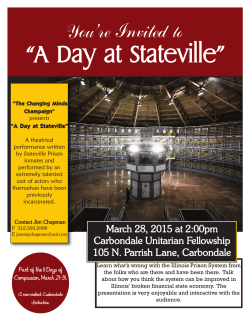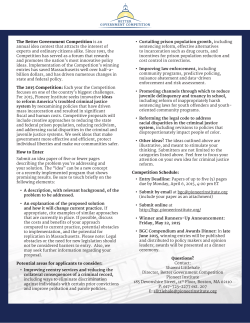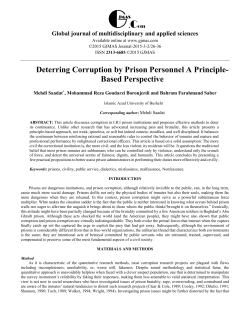
- USQ ePrints - University of Southern Queensland
Day 1 – Tuesday 17th March 2015 8:00 Registration and morning coffee 8:50 Opening remarks from the Chair of the day - Sarah Paddick, Principal Architect, Totalspace design An introductory overview of correctional services 9:00 Overview of Australian correctional systems and prison populations Trends in Australian prison populations Emerging issues and challenges for the prison environment Rights and responsibilities in prison planning and management Matthew Willis, Research Manager, Criminal Justice Monitoring and Analysis, Australian Institute of Criminology 9:35 Planning correctional facilities that meet the health needs of prisoners Professor Michael Levy AM, Australian National University 10:10 An update on investigations and complaints Deborah Glass OBE, Victorian Ombudsman 10:45 Morning tea 11:05 Shaping Corrections in the Northern Territory An insight into the Darwin Correctional Precinct Project The establishment of the Youth Justice Division Central focus on the training of prisoners Ken Middlebrook, Commissioner, Northern Territory Department of Correctional Services 11:40 Custodial Inspection in New South Wales Dr John Paget, Inspector of Custodial Services, New South Wales 1 12:15 An update on correctional services in Western Australia Professor Neil Morgan, Inspector of Custodial Services, Western Australia 12:50 Lunch is proudly sponsored by 1:50 PANEL DISCUSSION - With Australian prisons at capacity, how are the States and Territories dealing with the issue of overcrowding? How is crowding/overcrowding defined and understood? Discussing the reasons the overcrowding issue has become so severe What is the impact on prisoners themselves, on the prison officers and on the physical prison estate? What are the plans to alleviate the situation in the short and longer term? Session Chair: Stephen Myall, Magistrate, Magistrates Court of Victoria Panellists: Jan Shuard PSM, Commissioner, Corrections Victoria Professor Neil Morgan, Inspector of Custodial Services, Western Australia Dr John Paget, Inspector of Custodial Services, New South Wales Ken Middlebrook, Commissioner, Northern Territory Department of Correctional Services Innovation and evolution 2:40 Thinking inside the box - Innovation in recent prison design Prison architecture occurs in a closed setting, making the task of creating a ‘village’ a unique challenge. Looking at recent work by GBA and other prison architects internationally we will explore the results of applied innovation to the particular constraints of designing a prison. Andrew Thomas, Senior Architect, Guymer Bailey 3:15 Designing secure prisoner computer systems Over the past few years many jurisdictions in Australia and internationally have been looking towards implementing computers for prisoners for inmate education and societal reintegration. This talk discusses what is needed to implement a Prisoner Interactive Learning System securely while not compromising on the functions and features required by educators and health professionals. Ron Fabre, PrisonPC Lead Architect, Cyber IT Solutions 3:50 Afternoon tea 2 HR – Human Rights and Human Resources 4:10 International Approaches to the accommodation of Indigenous Prisoners The high incarceration rate of people from Indigenous cultures is a world-wide phenomenon. The reasons for overrepresentation vary in detail and multiplicity across different contexts but there are commonalities. This paper examines the manner in which various countries have sought to accommodate the differing needs of Indigenous prisoners. It outlines the Native American religious practices and ceremonies allowed in US prisons and some of the struggles associated with exercising religious freedoms. The partnerships forged between US correctional agencies and American Indian agencies to allow prisoners to serve time on reservations are also discussed. These experiences are contrasted to the Canadian experience of the establishment of healing lodges and the integration of Aboriginal religious ceremonies into mainstream prisons. Australian experiences have been vastly different and this presentation outlines the various approaches including the recent construction of a prison to meet the needs of Aboriginal prisoners in West Kimberley. In response to the large numbers of Māori imprisoned, New Zealand developed the concept of Māori Focus Units, built on the premise that increased cultural knowledge reduces the criminal behaviour. The Māori Focus Units and Pacific Islander Units present unique responses to incarcerating Indigenous prisoners. Finally, the paper outlines the establishment of the first prison in Greenland to respond to needs of the Kalaallit peoples. Dr. Elizabeth Grant, Senior Lecturer, The University of Adelaide 4:45 Prison Health and Safety – A Manager’s Perspective Examining management of OHS, particularly return to work in a prison setting, to have a positive impact on your workers compensation premium. Tangible things you can do in a heavily operational prison environment. A systems approach to managing incidents within a risk management framework Using Yammer to communicate the WHS message Integrated Case Review for better return to work outcomes Peter Hollis, Director - Human Resources, Queensland Corrective Services 3 Young offender management 5:20 CASE STUDY: Young offender management and rehabilitation - A case study on The Youth Unit at Port Phillip Prison An insight into The Youth Unit Programs and initiatives to reduce recidivism among young offenders The challenges of young offender management versus that of an adult Anne Hooker, Youth Development Officer, Port Phillip Prison 5:55 Closing remarks from the Chair of the day - Sarah Paddick, Principal Architect, Totalspace design 6:00 End of day 1 and networking drinks Networking drinks sponsored by: 4 Day 2 Wednesday 18th March 2015 8:30 Registration and morning coffee 8:50 Opening remarks from the Chair of the day - Professor Neil Morgan, Inspector of Custodial Services, Western Australia Reducing recidivism – international program and innovation 9:00 SKYPE SESSION CASE STUDY Taking the University to Prison: Reflections on the UK InsideOut prison exchange programme Professor Fiona Measham, Professor of Criminology, School of Applied Social Sciences Criminology, Durham University Planning and design of large scale infrastructure projects 9:35 Financial considerations in developing correctional facilities Examining the history – financing of Prison projects to date What are the current trends and processes in funding correctional facilities Whole of life costing and best value for money, ensuring most profitable outcome for all parties involved Different deals = different considerations. Examining the financing of different Prison projects in Australia and New Zealand Ya-Qun Xie, Associate Director, Macquarie Capital, Macquarie Group Limited 10:10 Future procurement of Australian prisons: Expanding service delivery in PPPs Service PPPs and the inclusion of core services Performance based contracting: - Revenue risk - Financial incentives for innovation, improved efficiencies and quality service delivery Case study: Ravenhall Prison - Victoria Nicole Evison, Senior Associate, Clayton Utz 5 10:45 Morning tea 11:05 CASE STUDY – An insight into the Wiri Prison Project Donal Lynch, Building + Interiors Construction Manager, Project Manager, Wiri Prison Project, Fletcher Construction 11:40 Knowledge through RealTime Visualisation Jeremy Harkins, Director, ineni Realtime/Lucid Edge 12:15 BUZZ DISCUSSION - Examining the future of correctional services in Australia Led by the Chair and some of the speakers of the day, this informal and interactive discussion is the chance for attendees to talk and reflect on what has been discussed at the conference thus far, voice opinions, share insights and expertise and discuss the future direction of correctional services in Australia. Nicole Evison, Senior Associate, Clayton Utz Dr Anna Eriksson, Senior Lecturer Criminology, School of Social Sciences, Monash University 12:35 Prison Cell Control Systems The days of prisoners spending their day working and only visiting their cells at night are a thing of the past. The extreme cases require prisoner lock up for as much as 23 hours a day. Through boredom, random acts of violence or just misuse, plumbing and electrical fittings get abused. So we raise the questions; How do we deal with water consumption in cells? - How can it be minimised without compromising inmate comfort? - Can we ensure waste pipes retain drain line carry in order to limit blockages when we demand lower water consumption? - How do we prevent drug disposal during searches? - How can staff offer flexibility when we demand strict limitations on plumbing fixture use? - What happens if there is a catastrophic failure of water supply – either through drought or mechanical equipment failure? How can we deal with unruly prisoners intent on damaging fittings and fixtures How can we control prisoner use of radios and TVs How can maintenance staff determine product failure without visiting a cell LWG Zurn’s presentation will demonstrate how Warden electronic controls can help deal with these issues Ian Strickett, Director, Macdonald Industries Limited 1:05 Lunch is proudly sponsored by 6 2:00 The Role of Education in a Recidivism Reduction Strategy Education and recidivism: what we know Planning for education in diverse prison populations Engaging Aboriginal and Torres Strait Islander prisoners USQ’s correctional digital education projects Helen Farley, Associate Professor (Digital Futures), the Australian Digital Futures Institute, University of Southern Queensland 2:35 Prison networks and the growing threat to information security: a focus on the ISM More than ever before, Australian networks face an unprecedented threat of malicious activity and loss of information. As prisons adopt an expanding technology platform to improve operations, facility management and correctional education, new modes of risk are continuing to grow. This session will focus on the current and emerging trend towards the Australian Government Information Security Manual (ISM), which provides a guideline for enhanced protection of network information. Travis Chehab, Associate, Norman Disney and Young 3:10 Afternoon tea Changing with the times – Correctional facilities with a softer feel 3:30 "People make the prison": Designing for human interaction What does a ‘good’ prison look like? That depends on the aims that prison is supposed to achieve. Containment, deterrence, punishment, and rehabilitation are all competing objectives, a lived and political reality causing uncertainty amongst staff in particular. Prisoners however, are less uncertain. For them, people make the prison, irrespective of design and security levels, a contradiction that raises important questions as to whether a focus on static or dynamic security is to be preferred. This presentation will discuss the results from a recently completed study that included empirical research in 14 prisons at all security levels in Australia and Norway, as well as a previous study discussing the last 200 years of prison development in the Anglophone and Nordic countries, with a particular focus on different prison designs and their impact. Dr Anna Eriksson, Senior Lecturer Criminology, School of Social Sciences, Monash University 7 4:05 The Design guidelines for creating more child-friendly prisons – encouraging the maintenance of family ties throughout a prison sentence Why is maintenance of family ties important? Location and Type of facility Staff Numbers of women and children Types of accommodation Visiting facilities and arrangements Communication Entry points and Screening areas A child’s perspective Successful Residential Parenting Programs Examples from Australia, New Zealand, the UK, Denmark, Canada and the US Sarah Paddick, Principal Architect, Totalspace design 4:40 Closing remarks from the Chair of the day - Professor Neil Morgan, Inspector of Custodial Services, Western Australia 4:45 End of day 2 and close of conference 8
© Copyright 2025











